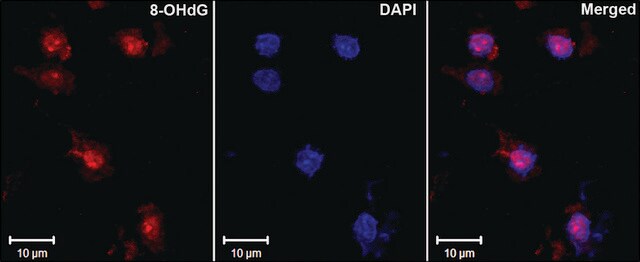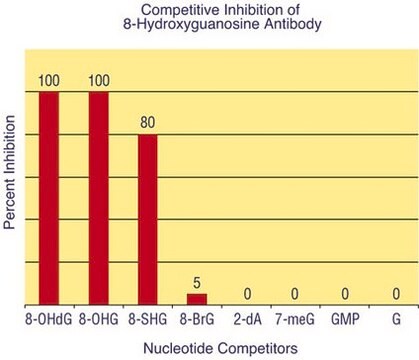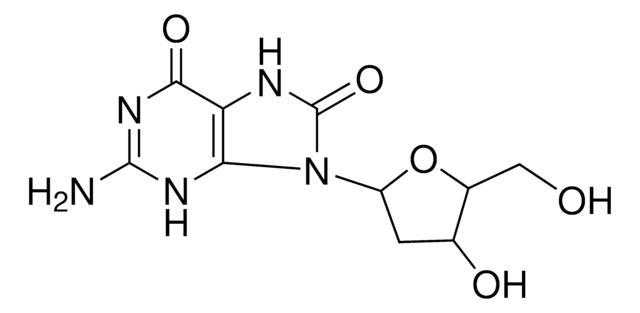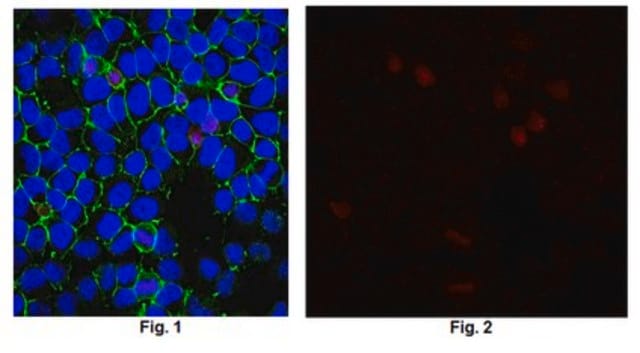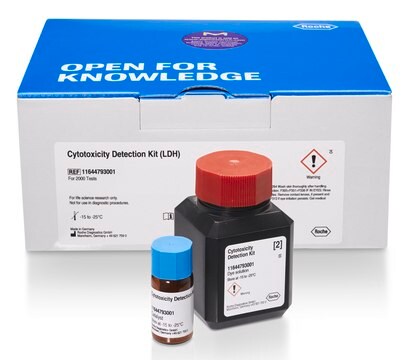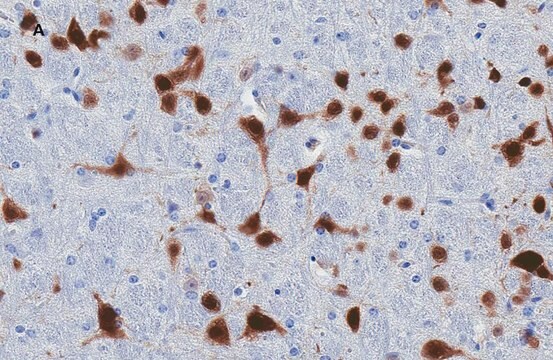MAB3560
Anti-8-Oxoguanine Antibody, clone 483.15
ascites fluid, clone 483.15, Chemicon®
Sinônimo(s):
8-oxoG
About This Item
Produtos recomendados
fonte biológica
mouse
Nível de qualidade
forma do anticorpo
ascites fluid
tipo de produto de anticorpo
primary antibodies
clone
483.15, monoclonal
reatividade de espécies
monkey, human, primate
reatividade da espécie (prevista por homologia)
mouse, rat
fabricante/nome comercial
Chemicon®
técnica(s)
ChIP: suitable
ELISA: suitable
immunocytochemistry: suitable
Isotipo
IgM
Condições de expedição
dry ice
modificação pós-traducional do alvo
unmodified
Informações sobre genes
human ... OGG1(4968)
Descrição geral
Especificidade
Imunogênio
Aplicação
On HeLa and Cos7 cells fixed with paraformaldehyde. 8-oxoguanine has been localized to the nucleus in nutrient-deprived cells.
ELISA:
Cell grown in slides were extracted twice for 30 sec with cold 560nM NaCl;0.1% (v/v) Triton X-100;0.02% (w/v) SDS;10mM phosphate buffer pH 7.4 and fixed with freshly prepared 4% PFA for 5-20 minutes at room temperature. {Conlon, KA et al (2000) J. Histotechnology 23(1):37-44}. Typical staining shows that nuclei from extracted cells have define periphery and areas of condensed chromatin. Clone 483.15 staining showed specific but faint nuclear fluorescence staining in cells incubated in supplemented DMEM, but in cells incubated in nutrient-free defined solt solution (NFDSS) {1.8mM calcium chloride, 110mM NaCl, 44mM sodium biocarbonate, pH 7.5} showed strong nuclear fluorescence staining that appeared punctate and gernerally distributed. Fluorescence staining disappears to background levels in cells incubated in nutrient medias even after initial NFDSS treatments {Conlon et al}.
A previous lot of this antibody was used in an ELISA assay.
Optimal working dilutions must be determined by end user.
Qualidade
Immunocytochemistry:
Confocal fluorescent analysis of NIH/3T3 cells using anti-8-oxoguanine mouse monoclonal antibody.
forma física
Armazenamento e estabilidade
Handling Recommendations: Upon receipt, and prior to removing the cap, centrifuge the vial and gently mix the solution. Aliquot into microcentrifuge tubes and store at -20°C. Avoid repeated freeze/thaw cycles, which may damage IgM and affect product performance.
Nota de análise
Nutrient starved HeLa or Cos7 cells
Outras notas
Informações legais
Não está encontrando o produto certo?
Experimente o nosso Ferramenta de seleção de produtos.
Código de classe de armazenamento
10 - Combustible liquids
Classe de risco de água (WGK)
nwg
Ponto de fulgor (°F)
Not applicable
Ponto de fulgor (°C)
Not applicable
Certificados de análise (COA)
Busque Certificados de análise (COA) digitando o Número do Lote do produto. Os números de lote e remessa podem ser encontrados no rótulo de um produto após a palavra “Lot” ou “Batch”.
Já possui este produto?
Encontre a documentação dos produtos que você adquiriu recentemente na biblioteca de documentos.
Nossa equipe de cientistas tem experiência em todas as áreas de pesquisa, incluindo Life Sciences, ciência de materiais, síntese química, cromatografia, química analítica e muitas outras.
Entre em contato com a assistência técnica